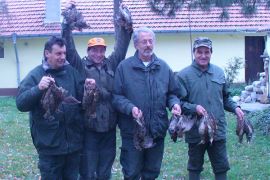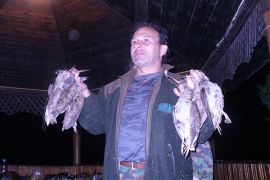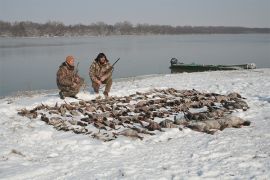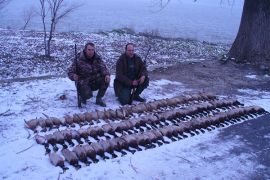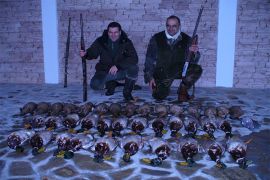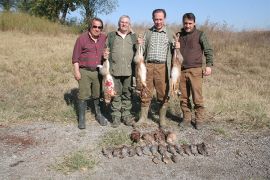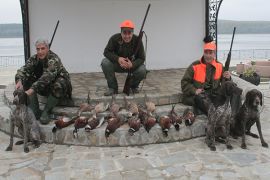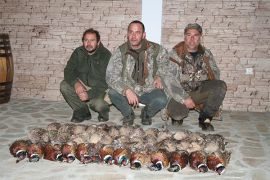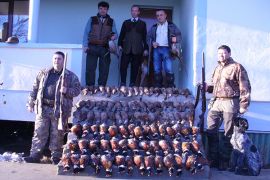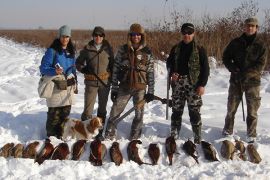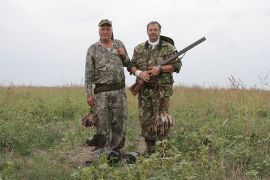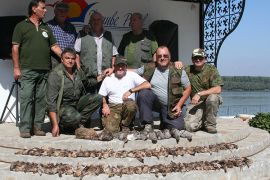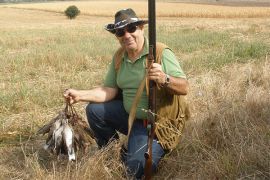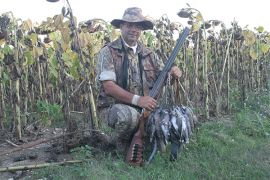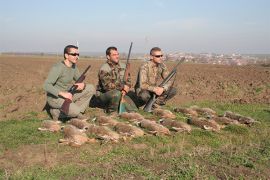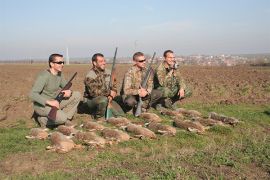Small game hunting trips in Bulgaria - Hunting area Калинка 6623
Small game hunting in Bulgaria - Hunting area Калинка 6623
- Hunting services - Small game hunting in Bulgaria
Bird hunting in Bulgaria - Hunting area Калинка 6623
- Hunting services - Bird hunting in Bulgaria
Goose hunting in Bulgaria - Hunting area Калинка 6623
- Hunting services - Goose hunting in Bulgaria
Wild duck hunting in Bulgaria - Hunting area Калинка 6623
- Hunting services - Wild duck hunting in Bulgaria
Pheasant hunting in Bulgaria - Hunting area Калинка 6623
- Hunting services - Pheasant hunting in Bulgaria
Woodcock hunting in Bulgaria - Hunting area Калинка 6623
- Hunting services - Woodcock hunting in Bulgaria
Quail hunting in Bulgaria - Hunting area Калинка 6623
- Hunting services - Quail hunting in Bulgaria
Turtle-dove hunting in Bulgaria - Hunting area Калинка 6623
- Hunting services - Turtle-dove hunting in Bulgaria
Partridge hunting in Bulgaria - Hunting area Калинка 6623
- Hunting services - Partridge hunting in Bulgaria
Wood pigeon hunting in Bulgaria - Hunting area Калинка 6623
- Hunting services - Wood pigeon hunting in Bulgaria
Find our discounted small game hunting trips in Bulgaria
- Small game hunting trips in Bulgaria directly from outfitters
» Bulgaria Hunting Trips » Small game hunting in Bulgaria » Hunting area Калинка 6623
- Hunting trips directly from outfitters:
Small game hunting trips in Bulgaria
Hunting area Калинка 6623
Book Your Small Game Hunt in Bulgaria
Bulgarian hunting areas offer individual and group hunting of pheasants, grey and rock partridge, migratory birds: quail, turtle-dove, wood pigeon, woodcock, various kind of ducks (mallard, garganey and common teal) and wild goose.
The season for a small game hunt in Bulgaria starts with quails, wild pigeon and turtle-dove hunting at the beginning of August on large agricultural lands sown with cereals cut by forest strips and water channels.
Some hunting areas along the Danube River offer successful hunting of wild ducks and geese.
Small game hunting trips in Bulgaria
Small game hunting in Bulgaria
- ✓ Small game hunting in Bulgaria
- Калинка 6623
Small game hunting in Bulgaria
Woodcocks hunting trips in Bulgaria
One of the most popular types of wing shooting in Bulgaria is woodcock hunting, and for good reason. These birds' migration route takes them directy through Bulgaria, making it one of the best woodcock hunting destinations in the world.
Woodcock hunts begin at around 9:00 AM, the best time being in daylight, with a pointing dog. The Setter and the Pointer have proved themselves invaluable helpers for this hunt. The woodcock is a secretive bird; most commonly encountered in forests, hence its name - woodcock. It likes to hide along the edge of the forest, in gullies, near small rivers, where the soil is soft and in short bushes (briar, blackberry and thorny bushes), but must be close to the forest. During rapid temperature drops, the woodcock can be found in pine forests, where the snow and rime can’t reach the ground.
There it spends the entire day feeding and resting, and manages to survive because the soil doesn’t freeze. Some of the best regions for hunting woodcocks can be found in Bulgaria. These regions maintain the vitally necessary for the bird temperature of 5 degrees Celsius. It’s a well-known fact that one of the biggest woodcock migration routes - via Pontica - passes through Bulgaria, making it one of the best hunting destinations for this bird in the world.
These birds stay for the longest time-period precisely in Bulgaria. Bulgarian hunters don’t have much interest in woodcocks, allowing mostly foreign hunters to indulge in this type of wingshooting in Bulgaria. The best habitats are near the Black sea, because the snow melts quickly thanks to the maritime climate. The hunting terrains are easily traversable because the soil is soft and lacks rocky areas. Some of the forests are sparse which allows for better visibility of the birds and more trophies.
The hunt for woodcocks is tremendously interesting because it is difficult, involves long treks and strong emotions. The best pointing dog for hunting these birds is the English setter. It has a firm stance, searches the places where the vegetation is thickest, has a good tempo and covers large areas. Unlike the Pointer it searches in a circular fashion and, most of the time, it tries to block the bird’s escape.
The Pointer has a good sense of smell, but searches further and in a straight line, which makes it possible for it to miss some of the birds. There are exceptions; some Pointers are very good in hunting woodcocks. Lately, we have begun to see the German shorthaired pointer in the forest, but the problem is that they track and give chase to furred game.
The best terrains for woodcock wingshooting in Bulgaria are short-stalked forests, clearings, and sparse beech, oak and coniferous forests as long as there are meadows frequented by livestock nearby. At night, woodcocks find their food in those meadows by burrowing.
Wood Pigeons hunting trips in Bulgaria
In the beginning of the season for wood pigeon hunting doesn’t differ from turtledoves as both animals are stalked in the same feeding spots (sunflower fields and harvested agricultural fields).
Hunters have to be at the hunting grounds at 7:00 AM and can hunt there until 11:00 AM. From 11:00 AM to 16:00 PM the birds can be stalked by the watering spots (beside rivers, swamps, overflows etc.) and the places where they rest (damp, sunless forests beside sunflower fields, acacia forests, dried tree trunks or massive singular trees from which the wood pigeon has the possibility to keep watch for any threats). Hunters need to be under the cover of a tree or at the edge of the forest and shoot only birds in flight. The period for this type of wingshooting in Bulgaria starts the beginning of August and ends on the 30th of October.
Wood pigeon hunting with lures:
Wood pigeons can be hunted with lures beginning from the 30th of October until the end of February. The hunting grounds are rice fields, harvested corn and sunflower fields etc. The most important thing about this hunt is observation, based on it we can determine where exactly the birds feed.
Using camouflage netting a hideout is constructed near the edge of the field. 20 to 40 artificial birds and two devices with rotating mock wood pigeons imitating landing birds and luring flocks. Spreading some additional food, found in the field (sunflower seeds, corn etc.), between the lures is recommended because the birds have excellent vision. Additionally a lone, static, wood pigeon is placed on a high place overlooking the field to play the role of a lookout.
Shooting range is 15-30 m.; firing before the bird lands gives the best results. When there is more than one person involved, the hunters are allowed to fire only on command.
Retriever dogs can be used for this type of wingshooting in Bulgaria. The dog must be well disciplined and must be able to stay still inside the hideout because the birds are suspicious when they notice movement. The hunters must stay still while in the hideout as well.
Weapon: Semi-automatic rifles are the preferred choice, but side-by-side or over/under shotguns can also be used. Barrel length should be between 66 and 76 cm and the chokes can be: |, ||, |||. The most commonly used rounds are № 6 ½ and № 7 ½, generally though you can use rounds ranging from № 5 to № 8
Accessories: camouflage netting, 3D camouflages, appropriate clothes that seamlessly blend in with the terrain.
Wild ducks hunting trips in Bulgaria
Wild duck hunting is one of the coldest and most exciting types of wing shooting in Bulgaria. There are three types of duck hunting. The first kind is at flight, early in the morning and at dusk. The second kind is with fake lures at the resting spots (reservoirs, dams, rivers and runoff water). The third kind is walked up hunting along river banks, canals and streams.
When hunting in the early hours of the morning, the hunters have to be at the hunting spots before dawn. The birds move from ther feeding spots towards the resting spots. Those are normally large dams and high-water rivers. Wearing warm clothes is recommended, but using camouflage coverings is a must, due to the fact that these birds have a sharp eyesight and a very acute sense of hearing. It is a good idea for hunters to use auditory decoys, so as to direct the birds towards themselves. You may use retriever dogs (Golden Retrievers, Labradors, Drahthaarts, Kurzhaarts and Setters). The dogs need to be very disciplined, compliant and to obey the command Stay in place!. Dogs with experience trace the shot birds by themselves and swiftly retrieve them for their guide.
During the hunts at dusk, it is advisable to lie in wait for the ducks at their feeding spots.
Those are: surface runoff areas (overland flow), harvested fields (rice fields), shallow streams, flooded corn fields (grooves filled with water). It is mandatory to use auditory decoys, so as to direct the birds towards the desired places. It is advisable to use retriever dogs, due to the fact that the hunt takes place in the darker hours of the day. For this kind of wing shooting in Bulgaria, using Drahthaars and Kurzhaars brings greater success. They are able to find the shot birds visually as well as by smell, while Labradors and Golden Retrievers tend to track the bird visually and are more suited for hunting at wide open water areas (reflective water surfaces).
Walked up hunting is the second method of hunting ducks. That is an emotion-filled outing involving long hikes, which is why the hunter must be in excellent health. This kind of hunt is most sucessful when the bigger dams in the area freeze over. Smaller canals and rivers do not allow the water to freeze even at temperatures below - 15 degrees. Birds are aware of that and they find favourable conditions to rest and eat. It is recommended to start this type of hunt at 6 am, and it can last until as late as 5 pm. It may then be combined with an evening hunt at dusk. Combined, the two types of hunt can bring wonderful results. During walked up hunts, it is good to use a guide who knows the places where the birds rest during the day. Once you near the resting spots, you need to move quietly and stay low. You need to use the surrounding vegetation as a cover while you approach the birds and use the element of surprise. It’s possible to lift between 20 and 50 birds into the air at one of these spots. When moving along a riverbank or canal, you need a disciplined dog that walks no more than 15 - 20 steps ahead of you. Once you near the resting spots, the dog must obey the command Heel! or Behind me! so as not to lift the resting game birds. In Bulgaria, the most widely established dog breeds are Drahthaar and Kurzhaar. Once the birds have been shot, the dogs must retrieve the birds from water as well as dry land under the command Retrieve!. The dog must be able to maneuvre through obstacles (water obstacles, fallen trees, ponds, etc.) - in other words, it needs to be hardy while retrieving.
The third kind of hunting is by lying in wait for the birds at their resting spots. Those are: large reservoirs (dams), surface runoffs. It is mandatory to use lures (decoys). It is advisable to put between 40 and 100 duck decoys into the water. It is good to have two or three pairs of spinning wing decoys (mojos). You may use mobile duck decoys with electric motors, so as to create the illusion that the birds are moving. The hunters need to have made a temporary hiding place at the river bank. It must blend in with the terrain so as not to arouse suspicion in the birds. A boat camouflaged with reed vegetation can be used for the same purpose. Hunting by boat allows the hunters to choose the hunting spots for themselves. When using decoys in such cases, they need to be mobile, with built-in chords and weights (so that they can be thrown directly from the boat).
Turtle-Doves hunting trips in Bulgaria
The turtle-dove’s passage begins at 7:30 AM and ends at 11:00, at the places where it feeds (sunflower fields), that is why the hunters have to be at the hunting grounds by 7:00 AM. Due to the fact that birds of the dove species use the same air corridors when flying, it is advised that the hunting guides research the hunting spots a day or two in advance.
The spots where the cover will be set to stalk the birds are decided on the basis of the collected information. After 11:00 AM if we’re not satisfied with the results, we can stalk the birds by their watering places (by rivers, swamps, overflows etc.), on the condition that there are trees, dried tree trunks, electrical posts and wires.
The use of retriever dogs is common practice. The dog must be very disciplined and adept at carrying out commands.
It should obey the commands: stay, lay down, fetch. An experienced dog has the ability to track the moving birds before the hunter and upon shooting to bring back the bird quickly and energetically, well remembering the shot bird’s exact spot. It must sit down in front of the hunter and give back the animal.
During a group hunt (in groups of 4 - 8 hunters), it’s advisable they cover all corridors of the passing birds, forcing them to keep flying in the air and giving the hunters a chance to continue shooting. The turtle-dove flies at speeds of 70 to 90 km/h and must be anticipated properly.
Snipes hunting trips in Bulgaria
Snipes are rarely the target of Bulgarian hunters, but there is quite the interest from foreign hunters.
This type of wing shooting in Bulgaria doesn’t require the hunters to get up early and can continue the entire day. Snipes are most commonly hunted in the so called overflows (fields that retain water, rice fields, spots where rivers have overflown and shallow lakes).
This is a bird that makes one of the longest migratory flights in the world. There is evidence that some specimens travel from Japan to Bulgaria. The hunt is very emotional and puts the hunter’s marksmanship skills to the test.
On liftoff snipes let out a cry which guides the hunter to the target. The problem is the bird makes sudden and sharp turns to either side and after the 30th meter straightens out its trajectory.
Missing the target is quite common. Out of the three types of snipes (small, common and large) the common snipe is allowed to be hunted in Bulgaria. Retriever dogs, which cope well with watery terrains, can be used.
The dogs must work very close to the hunter, at a distance no greater than 20 - 25 m. because the snipe lifts off at the 20th meter (the bird doesn’t allow the hunter to get close to it; the terrain doesn’t allow stealthy movement) and does so very quickly, making it quite difficult to hit.
English Setters have established themselves as the best dogs for this hunt. They have a good, firm stance and an exceptional sense of smell. Their fur protects them from the moisture and they can work all day.
Snipe hunting is allowed in the period from the beginning of August to the end of February. The best time for this type of wing shooting in Bulgaria is in December and January when most water basins freeze.
Quails hunting trips in Bulgaria
Quail hunting in Bulgaria - one of the two types of wing shooting in Bulgaria that can take place as early as August. Quail hunting is carried out primarily in the early hours of the day. It’s recommended you be at the hunting grounds by 6:00 AM.
In the beginning of the season, it is best you hunt until 10:00 AM and from 16:00 to 19:00 in the afternoon because of the high temperatures which impede the dogs work. During that period, it’s advisable you choose hunting grounds that are at greater altitudes. Practice shows us that quails prefer higher mountainous regions when the temperatures start to rise. They are most commonly encountered in meadows where different sorts of millet grow, in flat fields of harvested grain crops or the so called stubble fields where weeds are dominant.
The use of dogs of English breed (Pointer, Setter, etc.) is recommended. Hunting quails in passages is the most intense and successful method, when groups of 1000 to 3000 birds are formed. The season for this kind of wing shooting in Bulgaria is from the 1st of September to the 1st of October. During this period, temperatures are lower and it’s possible to hunt throughout the course of the entire day. A single hunter can shoot more than 100 birds during this type of hunt.
If the dogs are well trained, it is possible to shoot around 15 - 30 quails in about 2 - 4 hours. Our advice is to only shoot when the dog is in its pointing stance. That way there is equality between the hunter and the prey, and the hunt itself is pleasant. The dog has to be well trained, have a firm pointing stance and be a good retriever.
Young dogs can be brought along on this hunt, because they gain qualities and experience, making them better helpers when hunting other types of birds. The dog must work hard to find the game and, after the shot, bring it back to the hunter. If it learns to find quails then it will be able to find all other types of birds with ease. The recommended shooting distance is 20 to 30 meters. When the dog is standing still but there is nothing in front of it, it should be allowed to pick up the scent of the fleeing animal.
During group hunts the participant have to walk slowly and stop every 10 - 15 paces for about 30 seconds. That way the birds that press themselves down to the ground are forced to leave their cover and the dogs are given a chance to pick up their scents. When hunting in a group (4 - 5 hunters) we must always know the position of our fellow hunters. Whenever a person from the group fires their gun in an attempt to shoot down a bird, the others have to wait for him and then fire. Usually a region is searched with the group forming a line, complying with the safety measures.
The quails are completely wild; the populations are not mixed with birds raised in captivity. The best hunting period starts on the 1st of September and ends on the 1st of October. The hunting terrains are mountainous, hilly and farmlands.
Pheasants hunting trips in Bulgaria
Pheasant hunting is a fun and exciting type of wing shooting in Bulgaria's flatlands.
The hunt for pheasants begins at around 9:00 AM and can last the entire day. The terrain can be small, rolling hills, flatlands or along rivers and canals where thick vegetation is present.
Wild pheasants prefer hiding in thick bushes. The best places for this kind of wingshooting in Bulgaria are along the river Danube, in the northern part of the country. The hunt can be done in a group or individually, walking along rivers canals and the edges of forests.
When hunting pheasants in Bulgaria, continental pointing dogs find wider use, because the terrain is overgrown with thick vegetation where the English pointing dogs find difficulties. There are areas in Bulgaria where pheasants bred in reserves can be hunted. These birds live on huge patches of closed off land where they can grow much like their wild counterparts. They are bred in order to meet the numbers that hunters desire, especially during driven hunts.
Pheasants can be hunted all year round in Bulgaria at the designated places.
Partridges hunting trips in Bulgaria
Partridge Hunting in Bulgaria begins at around 9:00 AM, because the gallinaceous birds do not require the hunter to get up and be at the hunting grounds very early. This type of wing shooting in Bulgaria takes place in flatlands and regions with small, rolling hills.
Partridges found in Bulgaria are wild and their biggest populations reside near Plovdiv, where there are lots of uncultivated lands and fields of weeds. In these places partridges can easily hide and breed. Some flocks consist of more than 50 birds. It is possible to see 10 to 20 families a day. Partridges are hunted with pointing dogs, the Pointer and Setter being the breeds most commonly used. They scour bigger areas quickly and have a good firm stance.
Some Pointers can smell flocks from 100 m away. You can hunt individually or in a group. Nervous dogs are to be avoided (dogs that can’t hold their stance or are easily provoked by the moving birds in front of them, which in turn impedes the hunters’ advance). Partridges, when in danger, fly 300-600m from where they were standing and land again. That is why their flight path needs to be tracked.
We need to have good control over the dog so as to be able to regulate the search distance, especially when we know where the birds are. The families have a strong scent which makes them easy to find. It’s advisable, when hunting partridges, to try and break up the flock. Then they press to the ground longer and we can observe beautiful stances from the dogs.
This type of wing shooting in Bulgaria can last all day with a lot of ground covered with high tempo. That is why the hunter needs to be in good health.
Hares/Rabbits hunting trips in Bulgaria
Hares are one of the most popular species of game for Bulgarian hunters. Hare hunting is deeply enrooted in Bulgarian tradition.
There are two methods for hunting hares used in Bulgaria. One is on foot with pointing dogs, but the more preferred one is by driven hunt.
Usually flat, rolling and isolated patches of land are searched. Hares are hunted in groups, and the hunters usually align in a straight line within 6-10 paces of each other. During group hunts, safety precautions are of vital importance.
Shooting is only allowed in front of the hunter and behind them, while keeping in mind the position of the other participants in the hunt. Usually, plowed patches are searched, especially in windy conditions. The reason for this is that the hare lies down in a small burrow with its back to a big lump of dirt. This usually occurs during cold winter days.
Depending on the weather, hares can be encountered by the edge of fields and forests and in rolling terraced places, especially in rainy conditions. In these spots, the soil drains well and the hare can watch out for danger. They always choose high places (terraced hills, mounds, dams, etc.) for their burrows.
The dogs must work close to the hunters and, upon finding the hare, must freeze in a pointing stance in front of it. After the shot they must bring back the animal.
The hunters should be in good health due to the long treks in cold weather. A backpack is a must since each hunter carries their catch. Foreign hunters usually hunt with a guide and a carrier so this doesn’t always apply to them.
Geese hunting trips in Bulgaria
Goose hunting involves early mornings and very cold treks. This type of wing shooting in Bulgaria is effective while the birds are in flight in the morning and late afternoon.
In the morning the geese are stalked by the places they have rested at (big lakes and rivers). Places that offer a vantage point are chosen, allowing the hunters pick the birds off before they manage to climb beyond the hunters’ range. The best distance for shooting geese is about 30 to 40 m. This is a very resilient bird and that is why bigger pellets must be used (№ 1, № 0, № 2/0 and № 4/0).
In the late afternoon the geese can be stalked by the places they rest at overnight (big lakes and rivers), usually by the edge of the water. The use of goose calls is recommended in order to lure the birds in the desired direction. At dusk the shooting distance can range from 15 to 30 m.
The second way to hunt geese is at their feeding spots.These are fields with wheat crops still in the early stages of their growth, the main food source for the geese. After the field is chosen a hideout that blends in with its surroundings is constructed. The hideout can be set up some time before the hunt allowing the birds some time to get accustomed to its presence.
Decoys with and without spinning wings can be used as well as 3 artificial magpies and 50 to 100 static birds, mimicking a flock of feeding and resting geese. Other types of decoy birds can be used in order to create the illusion of a peaceful field. Shooting distance ranges between 15 to 30 m.
Hunters can use goose calls to direct the flocks to the desired spots and because the birds drop down from great heights the hunters must have patience and wait for them to come within range. Shooting is under the command of the guide (Now! etc.). These are powerful birds with good plumage. If shot at prematurely there is a chance to miss or wound the goose.
A retriever dog can be used. It must be well-disciplined and obey the command Stay! and must be kept inside the hideout. Geese hunts can last the entire day and the hunt itself is static and in cold weather.That is why heat insulating clothes, warm winter boots and neoprene socks are a must for this type of wing shooting in Bulgaria.
- BOOK YOUR HUNT IN BULGARIA
Още популярни ключови думи в ловния портал bghunters.com
- лов, hunting, BG Hunters, БГ Ловци, BGlov, бг лов, бглов, ловен форум, ловен сайт, ловен портал, обяви, продава, купува, ловни принадлежности, hunter, ловна телевизия, hunting TV, weekend TV, уикенд тв, Bulgarian news, hunting forum, caza, caccia, на лов, налов, na lov, nalov, лов бг, ловбг, lov, lovbg, нлрс-слрб, блрс, ловци, ловец, ловно куче, гонче, оръжие, патрони, нож, лък, курцхаар, дратхаар, сетер, пойнтер, палаш, Kendall Jones, Big Game Hunter, карабина, нарезно оръжие, гладкоцевно оръжие, пистолет, боеприпаси, пернат дивеч, дребен дивеч, едър дивеч, прасе, елен, сръндак, сърна, заек, лисица, вълк, чакал, язовец, глухар, яребица, пътпъдък, фазан, гривяк, гургулица, гълъб, гугутка, кеклик, дива коза, ловец бг, lovecbg, ловецбг, бг ловец, lovec, bglovec, козел, ловна дружина, сдружение, ловни новини, видео, ловни статии, галерия, файлове, ловни филми, хоби тв, състезания, изпитания, изпити, трайлер, пролетни изпитания, ловна кинология, киноложки клуб, ВДД-БГ, VDD-BG, германски дратхаар, kurzhaar, dahthaar, pointer, seter, ловен сезон, nalov, nalov, оптика, фенер, лов на едър дивеч, лов на дребен дивеч, пернати, лов на хищници, наслука, слука, соколарство, капан, сокол, орел, благороден елен, елен лопатар, дива свиня, глиган, приплод, природа, фотогалерия, ловен събор, гатер, фотолов, 4х4, оffroad, офроуд, ловно стопанство, дивечовъдно стопанство, законодателство, армада, оръжеен магазин, клубове, бракониери, ловен туризъм
- Hunters, Foreigners, STEYR-MANNLICHER, разселване, патица, гъска, горски бекас, бекасини, ягдтериер, подземен лов, териер, ловни разкази, опазване на дивеча, таксация, хранилка, Verney Carron, Sabatti, гравюра на оръжие, Stoeger, Стожер, Beretta, берета, Mauser, Маузер, Benelli, Бенели, Browning, Браунинг, Winchester, Taurus, Remington, Ремингтон, Бренеке, сачми, релоудинг, Sako, сако, ловни дрехи, патрондаш, CZ, ИЖ, Ижевски Оръжеен Завод, Росия, Mossberg, Мосберг, Merkel, Меркел, Grulla Armas, МЦ, ТОЗ, Сент Етиен, Smith § Wesson, FABARM, FAIR, рио, rio, Байкал, лов в България, платен лов, подборен лов, трофей, трофеен лов, лисугер, ARSEAL, Арсенал, Germanika, Imperator, Tikka, Rottweil, Perazzi, GLOCK, ZOLI, HUGLU
- стрелба, панички, стрелбище, пистолет, приклад, цев, полуложа, треньор, дресьор, стойка, отстрел, полеви състезания, свети хуберт, шампион, списание, български ловец, лов и куче, Voere, ловна карабина, индивидуален лов, групов лов, птичи лов, калибър, сайга, мазалат, лов в африка, бързомер, оптичен уред, нощен лов, пневматично оръжие, млад ловец, ловен курс, ловни породи, обучение, съдия, изложба, екстериор, развъдник, обяви, продава, купува, родословие, брфк, бркс, FCI, спортна стрелба, смях, риболов, на риба, рибар, сладководен, язовир, река, джип, кола, клетка, храна за куче, клипчета, видео канал, звуци на животни, екология, туризъм, ловен календар, фази на луната, лунен календар, ловни игри, имейл, кръвоследник, апорт от вода, рога, бюлетин, оръжейник, скийт, трап, рецепти от дивеч, екипировка, ловен туризъм, ЗЛОД, закон за лова, правилник, национален клуб курцхаар, vdd bg, българско лудогорско гонче, българско трицветно гонче, български барак, английски сетер, клуб българско гонче, национален клуб немски ловен териер, полигон, Labrador, лабрадор, конкурс, анкета, онлайн магазин, електронен магазин, спорт, елек, шапка, ботуш, ловно сдружение, академия найк, ветренски
- VDD e V, Fuchswiese, Vom Sakar, вом Хаус Пав, Belmeken, Balkanite, Vom Tangra, Chaushev kennel, мечка, стръвница, камера на живо, пусия, бележка, вреден дивеч, примамка, ловна камера, бийпър, телетакт, машинка, сврака, сива врана, рис, дива котка, подивели кучета, скитащи кучета, енотовидно куче, пасаж, стървилище, препариране, прапарация, оръжейна литература, ловна литература, балистика, бенчрест, амуниции, impala, флоберка, Блазер, Blaser, shooting, chase, shoot, field sports, shikar, gunning, gunner, fowler, sportsman, courser, shikaree, shikari, arms, weapon, arsenal, game, hunting forum, hunting portal, ловни новини, видео новини, hunting news, hunting video, Български ловец, лов и куче, списание, вестник, телевизия, TV, авто, auto, туризъм, фото, чат, музика, блог, blog, сподели, youtube, информация, Bglovcom`s Channel, Huntducks, ducks, duck, национален клуб българско гонче, НКК, information, USA, Canada, Africa, Europa, Bulgaria, Гърция, Greece, crisis, криза, economic crisis, охотников, охота, lov forumu, охотничий форум, охотничий сайт, охота новости, оружие, Online, Авто, коли, мотори, авточасти, застраховки, кредити, магазини, дрехи и аксесоари, бижута, подаръци, групово пазаруване, сайтове за обяви, търсене на работа, задръствания, прогноза на времето, мобилни телефони, навигация, безжични технологии, интернет-доставчици, VoIP телефония, БДЗП, българско дружество за защита на птиците, природозащита, ghost hunting, turkey hunting, Hunter Mountain, hunter live, hunter tv, livescore hunter, lego, Facebook, YouTube, Outlook, Dog, Animal, Football, fish hunter, duck hunting, hunting boots, hunting packs, perro, къща за гости, guest house, hunting lodge
- частни ловни стопанства в странджа
- монголски фазан
- ловни магазини пловдив
- оръжеен магазин велико търново
- бг лов
- оръжеен магазин дупница
- рецепти за фазан
- рецепти за патица
- звук на дива патица
- трофейни дъски
- ловни патрони братан
- магазини за дивечово месо
- обучение на ловно куче свинар
- лятно бърне
- скален гълъб
- ловни аксесоари
- капан за фазани
- рецепти с пъстърва
- пъдпъдък звук
- размножаване на зайци
- ловецбг
- ловен магазин велико търново
- уеб камера мазалат
- развъдник за ягдтериер хасково
- пердета стрелбище
- ловни магазини в пловдив
- ловни дрехи за гоначи
- разрешително за флоберка
- черен кос огняново
- най добрата ловна карабина
- ловни пушки
- рецепти с патица
- бг лов бракониери
- дива патица рецепта
- заек рецепта
- ловец бг
- колхидски фазан цена
- ловни магазини
- лов бг
- оръжеен магазин онлайн
- оръжейни магазини софия адреси
- развъдник за фазани
- тракийски кеклик
- лов на глигани в българия
- хижа ловна
- ловци
- ловните трофеи и тяхната оценка
- гонки с кучета
- лов в Калинка 6623
- лов на бекас в Калинка 6623
- лов на бекасина в Калинка 6623
- лов на благороден елен в Калинка 6623
- лов на бозайници в Калинка 6623
- лов на бялка в Калинка 6623
- лов на видра в Калинка 6623
- лов на водоплаващ дивеч в Калинка 6623
- лов на вреден дивеч в Калинка 6623
- лов на вълк в Калинка 6623
- лов на глухар в Калинка 6623
- лов на голяма белочела гъска в Калинка 6623
- лов на горски бекас в Калинка 6623
- лов на гривяк в Калинка 6623
- лов на гугутка в Калинка 6623
- лов на гургулица в Калинка 6623
- лов на гълъб хралупар в Калинка 6623
- лов на гъска в Калинка 6623
- лов на див заек в Калинка 6623
- лов на дива коза в Калинка 6623
- лов на дива котка в Калинка 6623
- лов на дива свиня в Калинка 6623
- лов на диво прасе в Калинка 6623
- лов на дребен дивеч в Калинка 6623
- лов на едър дивеч в Калинка 6623
- лов на елен-лопатар в Калинка 6623
- лов на енотовидно куче в Калинка 6623
- лов на заек в Калинка 6623
- лов на зеленоглава патица в Калинка 6623
- лов на зимно бърне в Калинка 6623
- лов на златка в Калинка 6623
- лов на катерица в Калинка 6623
- лов на кафява мечка в Калинка 6623
- лов на клопач в Калинка 6623
- лов на колхидски фазан в Калинка 6623
- лов на корейски фазан в Калинка 6623
- лов на кошута в Калинка 6623
- лов на лисица в Калинка 6623
- лов на ловни птици в Калинка 6623
- лов на лопатарка в Калинка 6623
- лов на лятно бърне в Калинка 6623
- лов на монголски фазан в Калинка 6623
- лов на муфлон в Калинка 6623
- лов на невестулка в Калинка 6623
- лов на нутрия в Калинка 6623
- лов на обикновен фазан в Калинка 6623
- лов на обикновена бекасина в Калинка 6623
- лов на обикновена дива патица в Калинка 6623
- лов на ондатра в Калинка 6623
- лов на патиц в Калинка 6623
- лов на пернати в Калинка 6623
- лов на планински кеклик в Калинка 6623
- лов на полудива патица в Калинка 6623
- лов на посевна врана в Калинка 6623
- лов на пръстенчат фазан в Калинка 6623
- лов на пъдпъдък в Калинка 6623
- лов на пъстър пор в Калинка 6623
- лов на рогач в Калинка 6623
- лов на свирачка в Калинка 6623
- лов на сврака в Калинка 6623
- лов на сива врана в Калинка 6623
- лов на сива гъска в Калинка 6623
- лов на скален гълъб в Калинка 6623
- лов на скорец в Калинка 6623
- лов на сръндак в Калинка 6623
- лов на сърна в Калинка 6623
- лов на токачка в Калинка 6623
- лов на тракийски кеклик в Калинка 6623
- лов на фазан в Калинка 6623
- лов на фиш в Калинка 6623
- лов на хищници в Калинка 6623
- лов на чавка в Калинка 6623
- лов на чакал в Калинка 6623
- лов на черен пор в Калинка 6623
- лов на черна качулата потапница в Калинка 6623
- лов на шилар в Калинка 6623
- лов на шилоопашата патица в Калинка 6623
- лов на юрдек в Калинка 6623
- лов на язовец в Калинка 6623
- лов на яребица в Калинка 6623
- лов с куче в Калинка 6623
- ловен излет в Калинка 6623
- ловен магазин в Калинка 6623
- ловен район в Калинка 6623
- ловен туризъм в Калинка 6623
- ловна дружина в Калинка 6623
- ловно поле в Калинка 6623
- ловно рибарски магазин в Калинка 6623
- ловно сдружение в Калинка 6623
- ловно стопанство в Калинка 6623
- ловно-рибарско дружество в Калинка 6623
- магазин за дивечово месо и деликатеси в Калинка 6623
- hunting in Bulgaria
- hunting services in Bulgaria - Калинка 6623
- red deer hunting in Bulgaria - Калинка 6623
- fallow deer hunting in Bulgaria - Калинка 6623
- roe deer hunting in Bulgaria - Калинка 6623
- wild boar hunting from a high seat in Bulgaria - Калинка 6623
- driven wild boar hunting in Bulgaria - Калинка 6623
- mouflon hunting in Bulgaria - Калинка 6623
- chamois hunting in Bulgaria - Калинка 6623
- bezoar ibex hunting in Bulgaria - Калинка 6623
- barbary sheep hunting in Bulgaria - Калинка 6623
- himalayan tahr hunting in Bulgaria - Калинка 6623
- wood grouse hunting in Bulgaria - Калинка 6623
- pheasant hunting in Bulgaria - Калинка 6623
- woodcock hunting in Bulgaria - Калинка 6623
- quail hunting in Bulgaria - Калинка 6623
- turtle-dove hunting in Bulgaria - Калинка 6623
- partridge hunting in Bulgaria - Калинка 6623
- wood pigeon hunting in Bulgaria - Калинка 6623
- wild duck hunting in Bulgaria - Калинка 6623
- geese hunting in Bulgaria - Калинка 6623
- rabbiting in Bulgaria - Калинка 6623
- european hare hunting in Bulgaria - Калинка 6623
- hare hunting in Bulgaria - Калинка 6623
- rabbit hunting in Bulgaria - Калинка 6623
- wildfowling in Bulgaria - Калинка 6623
- waterfowl in Bulgaria - Калинка 6623
- big game hunting in Bulgaria - Калинка 6623
- small game hunting in Bulgaria - Калинка 6623
- predator hunting in Bulgaria - Калинка 6623

